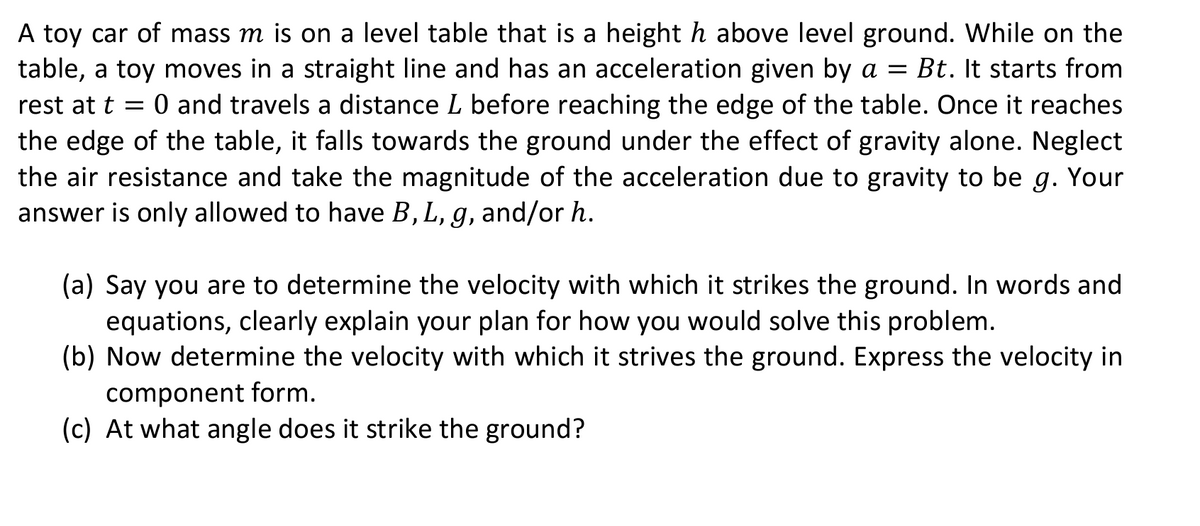A toy car of mass m is on a level table that is a height h above level ground. While on the table, a toy moves in a straight line and has an acceleration given by a = Bt. It starts from rest at t = 0 and travels a distance L before reaching the edge of the table. Once it reaches the edge of the table, it falls towards the ground under the effect of gravity alone. Neglect the air resistance and take the magnitude of the acceleration due to gravity to be g. Your answer is only allowed to have B, L, g, and/or h. (a) Say you are to determine the velocity with which it strikes the ground. In words and equations, clearly explain your plan for how you would solve this problem. (b) Now determine the velocity with which it strives the ground. Express the velocity in component form. (c) At what angle does it strike the ground?
A toy car of mass m is on a level table that is a height h above level ground. While on the table, a toy moves in a straight line and has an acceleration given by a = Bt. It starts from rest at t = 0 and travels a distance L before reaching the edge of the table. Once it reaches the edge of the table, it falls towards the ground under the effect of gravity alone. Neglect the air resistance and take the magnitude of the acceleration due to gravity to be g. Your answer is only allowed to have B, L, g, and/or h. (a) Say you are to determine the velocity with which it strikes the ground. In words and equations, clearly explain your plan for how you would solve this problem. (b) Now determine the velocity with which it strives the ground. Express the velocity in component form. (c) At what angle does it strike the ground?
University Physics Volume 1
18th Edition
ISBN:9781938168277
Author:William Moebs, Samuel J. Ling, Jeff Sanny
Publisher:William Moebs, Samuel J. Ling, Jeff Sanny
Chapter6: Applications Of Newton's Laws
Section: Chapter Questions
Problem 40P: A service elevator takes a load of garbage, mass 10.0 kg, from a floor of a skyscraper under...
Related questions
Topic Video
Question

Transcribed Image Text:A toy car of mass m is on a level table that is a height h above level ground. While on the
table, a toy moves in a straight line and has an acceleration given by a = Bt. It starts from
rest at t = 0 and travels a distance L before reaching the edge of the table. Once it reaches
the edge of the table, it falls towards the ground under the effect of gravity alone. Neglect
the air resistance and take the magnitude of the acceleration due to gravity to be g. Your
answer is only allowed to have B, L, g, and/or h.
(a) Say you are to determine the velocity with which it strikes the ground. In words and
equations, clearly explain your plan for how you would solve this problem.
(b) Now determine the velocity with which it strives the ground. Express the velocity in
component form.
(c) At what angle does it strike the ground?
Expert Solution
Introduction:
Basic concept of equation of motion:
- We always use equation of motions to determine final velocity at a distance D from the initial position, constant acceleration of a moving object if time of travel and distances are known.
- Constant acceleration is must for using equation of motion.
- If acceleration (a) of an object is not constant and depends upon time, like, a= C t, where a is dependent on time (t), then we have to integrate with reference to initial conditions of the problem to achieve final velocity of an object.
- In free fall condition from a height h, an object is under effect of gravity only.
Trending now
This is a popular solution!
Step by step
Solved in 2 steps with 1 images

Knowledge Booster
Learn more about
Need a deep-dive on the concept behind this application? Look no further. Learn more about this topic, physics and related others by exploring similar questions and additional content below.Recommended textbooks for you

University Physics Volume 1
Physics
ISBN:
9781938168277
Author:
William Moebs, Samuel J. Ling, Jeff Sanny
Publisher:
OpenStax - Rice University

University Physics Volume 1
Physics
ISBN:
9781938168277
Author:
William Moebs, Samuel J. Ling, Jeff Sanny
Publisher:
OpenStax - Rice University